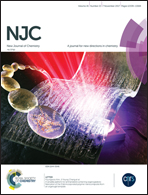Synthesis, characterization, crystal structure, electrochemical, solvatochromic and biological investigation of novel N4 and N3 type Cu(ii) Schiff base complexes†
Abstract
In the present study, three novel Cu(II) Schiff base complexes [CuL](ClO4)2, [CuL′Cl2] and [CuL′(NO3)2] (L: N,N′-bis(2-pyridinylmethylene)-1,2-diphenylethylenediamine and L′: N-(2-pyridinylmethylene)-1,2-diphenylethylenediamine) were synthesized and characterized using infrared spectroscopy, elemental analysis, conductivity measurements and X-ray crystallography. The crystal structure of the [CuL′(NO3)2] and [CuL′Cl2] complexes were determined by X-ray crystallography. However, suitable single crystals for [CuL](ClO4)2 could not be obtained. The complexes were assessed to determine their thermal, electrochemical and biological behaviors and electronic absorption. Among the complexes, only the [CuL](ClO4)2 complex showed solvatochromic properties in various solvents. The antibacterial activities of these complexes were evaluated in Muller-Hinton broth against Staphylococcus aureus, Escherichia coli and Enterococcus faecalis using the serial dilution technique at concentrations ranging from 2 to 0.0625 mg mL−1. The data demonstrates that the complexes were bacteriostatic agents that inhibit bacterial growth, but had no bactericidal properties.



 Please wait while we load your content...
Please wait while we load your content...